Spatial Distribution of, and Variations in, Cold Regions in China from 1961 to 2019
Abstract
:1. Introduction
2. Data and Methods
2.1. Data Sources
- Temperature data: The indicators used in this study were all temperature indices. The temperature data were the monthly temperature values for 612 meteorological stations in China from January 1961 to December 2019, which were downloaded from the China Meteorological Data Network (http://data.cma.cn accessed on 21 September 2020). All the 612 stations have complete data availability and there are no gaps. The distribution of the meteorological stations is shown in Figure 1.
- Elevation data: The digital elevation model (DEM) data were obtained from the cloud geospatial database (http://www.gscloud.cn/ accessed on 20 September 2020), with a resolution of 1 km × 1 km.
2.2. Methods
2.2.1. Spatial Interpolation of Meteorological Data
2.2.2. Trend Analysis Method
2.2.3. Spatial Similarity Analysis
2.2.4. Mann–Kendall Mutation Test
3. Results and Analysis
3.1. Time Series Changes in the Area of Cold Regions in China from 1961 to 2019
3.2. Spatial Distribution of the Cold Regions in China from 1961 to 2019
3.3. Spatial Variations in the Cold Regions in China from 1961 to 2019
4. Discussion
5. Conclusions
Author Contributions
Funding
Institutional Review Board Statement
Informed Consent Statement
Data Availability Statement
Conflicts of Interest
References
- Shen, H. Colde Regions Science and Marine Technology; Eolss Publishers Company Limited: Oxford, UK, 2015. [Google Scholar]
- Gelfan, A.N.; Motovilov, Y.G. Long-term Hydrological Forecasting in Cold Regions: Retrospect, Current Status and Prospect. Geogr. Compass 2009, 3, 1841–1864. [Google Scholar] [CrossRef]
- Yang, Z.N. Glacier Water Resources in China; Gansu Science and Technology Press: Lanzhou, China, 1991; pp. 1–5. [Google Scholar]
- Vaughan, D.G.; Comiso, J.C.; Allison, I.; Carrasco, J.; Kaser, G.; Kwok, R.; Mote, P.; Murray, T.; Paul, F.; Ren, J. Observations: Cryosphere. Clim. Chang. 2013, 2103, 317–382. [Google Scholar]
- Hu, Z.Y.; Kuenzer, C.; Dietz, A.J.; Dech, S. The Potential of Earth Observation for the Analysis of Cold Region Land Surface Dynamics in Europe—A Review. Remote Sens. 2017, 9, 1067. [Google Scholar] [CrossRef] [Green Version]
- Farquharson, L.M.; Romanovsky, V.E.; Cable, W.L.; Walker, D.A.; Kokelj, S.V.; Nicolsky, D. Climate change drives widespread and rapid thermokarst development in very cold permafrost in the Canadian High Arctic. Geophys. Res. Lett. 2019, 46, 6681–6689. [Google Scholar] [CrossRef] [Green Version]
- Nitzbon, J.; Westermann, S.; Langer, M.; Martin, C.P.L.; Strauss, J.; Laboor, S.; Boike, J. Fast response of cold ice-rich permafrost in northeast Siberia to a warming climate. Nat. Commun. 2020, 11, 1–11. [Google Scholar] [CrossRef]
- Ran, Y.; Li, X.; Cheng, G. Climate warming over the past half century has led to thermal degradation of permafrost on the Qinghai–Tibet Plateau. Cryosphere 2018, 12, 595–608. [Google Scholar] [CrossRef] [Green Version]
- Gobiet, A.; Kotlarski, S.; Beniston, M.; Heinrich, G.; Rajczak, J.; Stoffel, M. 21st century climate change in the European Alps—A review. Sci. Total Environ. 2014, 493, 1138–1151. [Google Scholar] [CrossRef]
- Maurer, J.M.; Schaefer, J.M.; Rupper, S.; Corley, A. Acceleration of ice loss across the Himalayas over the past 40 years. Sci. Adv. 2019, 5, eaav7266. [Google Scholar] [CrossRef] [Green Version]
- IPCC. 2021: Summary for Policymakers. In Climate Change 2021: The Physical Science Basis. Contribution of Working Group I to the Sixth Assessment Report of the Intergovernmental Panel on Climate Change; Cambridge University Press: Cambridge, UK, 2021. [Google Scholar]
- Yan, Z.W.; Ding, Y.H.; Zhai, P.M.; Song, L.C.; Cao, L.J.; Li, Z. Re-assessing climatic warming in China since the last century. Acta Meteorol. Sin. 2020, 78, 370–378. (In Chinese) [Google Scholar] [CrossRef]
- Yang, Z.N.; Zeng, Q.Z. Glacier Hydrology; Chongqing Press: Chongqing, China, 2001; p. 48. (In Chinese) [Google Scholar]
- Yang, Z.N. Research on Cold Regions Hydrology in China; Science Press: Bejing, China, 1997; pp. 50–56. (In Chinese) [Google Scholar]
- Koppen, W. Das Geographische System der Klimate. In Hand-Buch der Klimatologie; Borntrager: Berlin, Germany, 1936; Volume 1, Part C. [Google Scholar]
- Gerdel, R.W. Characteristics of the Cold Regions; Cold Regions Research and Engineering Laboratory, US Army Corps of Engineers: Hanover, NH, USA, 1969; p. 51. [Google Scholar]
- Wilson, C. Cold Regions Climatology; Cold Regions Research and Engineering Laboratory, US Army Corps of Engineers: Hanover, NH, USA, 1967; p. 147. [Google Scholar]
- Hamelin, L.E. Canadian Nordicity: It’s Your North Too; Harvest House: Eugene, OR, USA, 1979; p. 373. [Google Scholar]
- Yang, Z.; Liu, X.; Zeng, Q. Hydrology in Cold Regions of China; Science Press: Beijing, China, 2000; pp. 2–21. (In Chinese) [Google Scholar]
- Chen, R.S.; Kang, E.S.; Wu, L.Z.; Yang, J.P.; Ji, X.B.; Zhang, Z.B. Cold Regions in China. J. Glaciol. Geocryol. 2005, 27, 469–475. (In Chinese) [Google Scholar] [CrossRef]
- Su, B.D.; Sun, H.M.; Li, X.C.; Li, Z.J.; Zhang, J.P.; Wang, Y.J.; Huang, J.L.; Gao, M.N.; Jiang, T.; Si, L.L. Impact of climate change on terrestrial water cycle in China. Trans. Atmos. Sci. 2020, 43, 1096–1105. (In Chinese) [Google Scholar] [CrossRef]
- Ding, Y.J.; Liu, S.Y.; Ye, B.S.; Zhao, L. Climatic Implications on Variations of Lakes in the Cold and Arid Regions of China during the Recent 50 Years. J. Glaciol. Geocryol. 2006, 28, 623–632. (In Chinese) [Google Scholar]
- Li, B.Q.; Xiao, W.; Wang, Y.C.; Sun, Q.Y.; Liu, Z.Y. Recent research progress in the hydrological cycle model of cold regions. J. Southwest Univ. Natl. 2018, 44, 338–346. (In Chinese) [Google Scholar]
- Wang, Z.C.; Zhang, Y.; Zhang, Y.; Yang, C.Y.; Yuan, K. Experimental Research on Intelligent Energy—Saving Ventilation System in Cold Regions. Energy Conserv. Technol. 2021, 39, 117–122. (In Chinese) [Google Scholar]
- Liu, Z.H.; Li, L.T.; McVicar, T.R.; Van Niel, T.G.; Yang, Q.R.; Li, R. Introduction of the Professional Interpolation Software for Meteorology Data: ANUSPLIN. Meteorol. Mon. 2008, 92–100. (In Chinese) [Google Scholar] [CrossRef]
- Guo, Y.B.; Guo, W.; Qin, Y.C.; He, Q.; Zhang, X.J.; Wu, C. Consistency check based on Kappa coefficient and its software implementation. Chin. J. Health Stat. 2016, 33, 169–170. (In Chinese) [Google Scholar]
- Mann, H.B. Nonparametric test against trend. Econometrica 1945, 13, 245–259. [Google Scholar] [CrossRef]
- Lin, J.J.; Zhang, Q. Characteristics of China Climate States Change and Its Impact on the Analysis of Climate Change. Plateau Meteorol. 2015, 34, 1593–1600. (In Chinese) [Google Scholar] [CrossRef]
- Shen, Y.P.; Wang, G.Y. Key findings and assessment results of IPCC WGI Fifth Assessment Report. J. Glaciol. Geocryol. 2013, 35, 1068–1076. (In Chinese) [Google Scholar] [CrossRef]
- Liu, F.; Wu, L.M.; Chen, L.C.; Wang, K.; Ma, J.H.; Zhang, J.L. Trend and abrupt change of air temperature in China in recent 60 years based on GIS. Agric. Sci. Technol. Inf. 2015, 6, 74–78. (In Chinese) [Google Scholar] [CrossRef]
- Chen, L.X.; Zhu, W.Q.; Wang, W.; Zhou, X.J.; Li, W.L. Study on climate change in China in recent 45 years. Acta Meteorol. Sin. 1998, 56, 2–16. (In Chinese) [Google Scholar] [CrossRef]
- Hai, Y.; Gao, Z.Q. The analysis of temporal and spatial features of climate change in the last 100 years in China. Bull. Sci. Technol. 2010, 26, 58–62. (In Chinese) [Google Scholar] [CrossRef]
- Liang, L.T.; Ma, L.; Liu, Y.X.; Sun, B.L.; Zhou, Y. Spatiotemporal variation of the temperature mutation and warming hiatus over northern China during 1951~2014. China Environ. Sci. 2018, 38, 1601–1615. (In Chinese) [Google Scholar] [CrossRef]
- Kang, S.C.; Guo, W.Q.; Wu, T.H. Cryospheric changes and their impacts on water resources in the Belt and Road regions. Adv. Earth Sci. 2020, 35, 1–17. (In Chinese) [Google Scholar] [CrossRef]
- Yao, T.D.; Qin, D.H.; Shen, Y.P.; Zhao, L.; Wang, N.L.; Lu, A.X. Cryospheric changes and their impacts on regional water cycle and ecological conditions in the Qinghai-Tibetan Plateau. Chin. J. Nat. 2013, 35, 179–186. (In Chinese) [Google Scholar]
- Shen, Y.P.; Su, H.C.; Wang, G.Y. The responses of glaciers and snow cover to climate change in Xinjiang (Ⅱ): Hazards effects. J. Glaciol. Geocryol. 2013, 35, 1355–1370. (In Chinese) [Google Scholar]
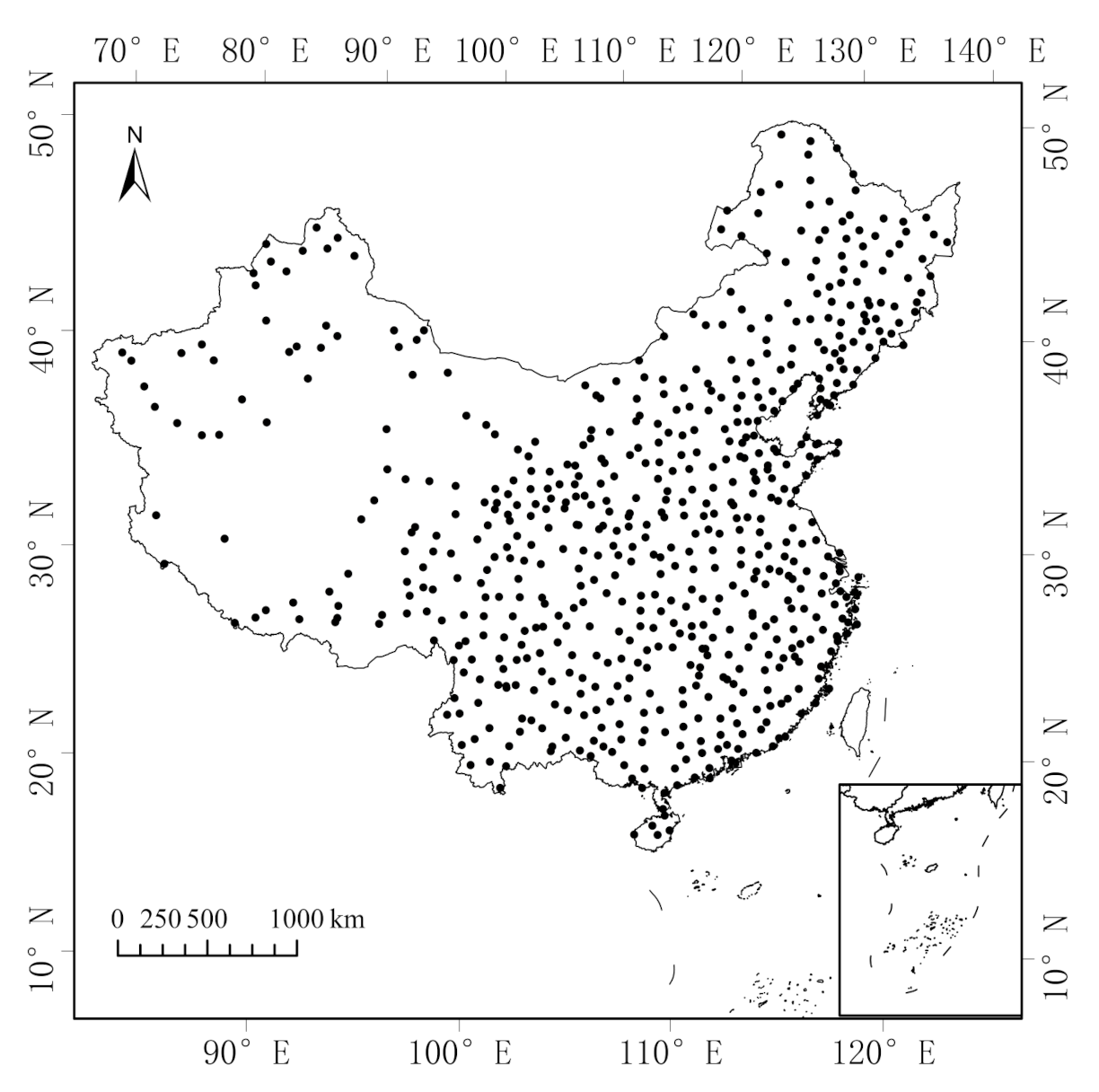
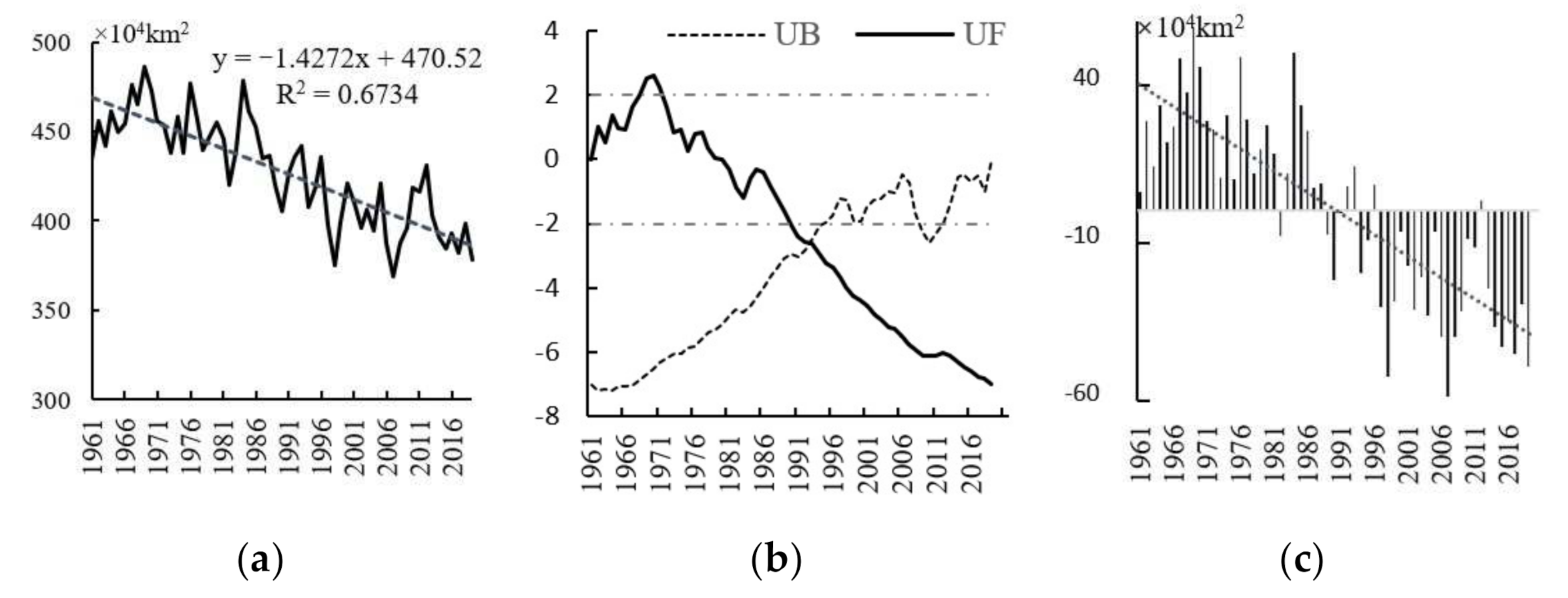
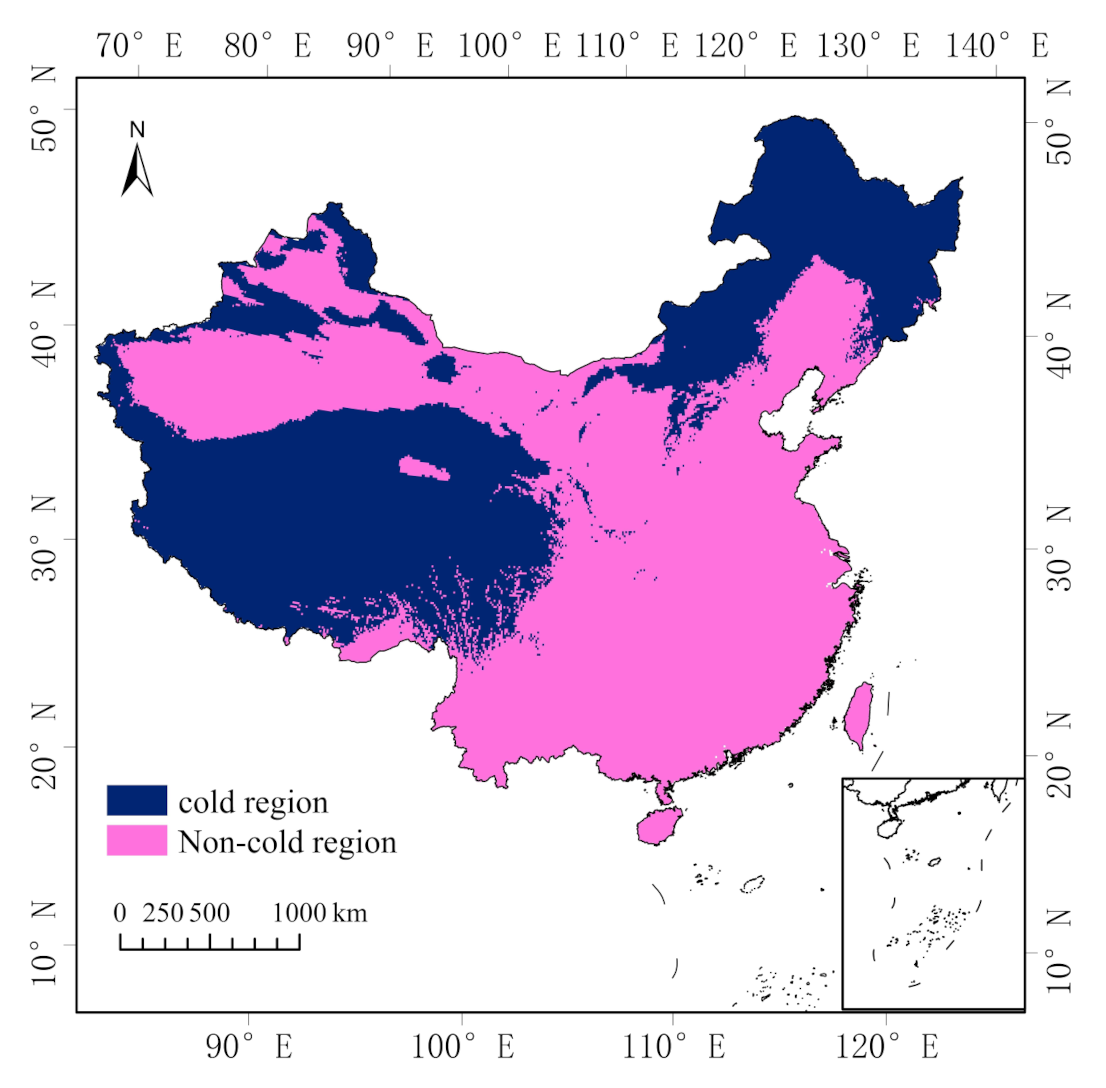
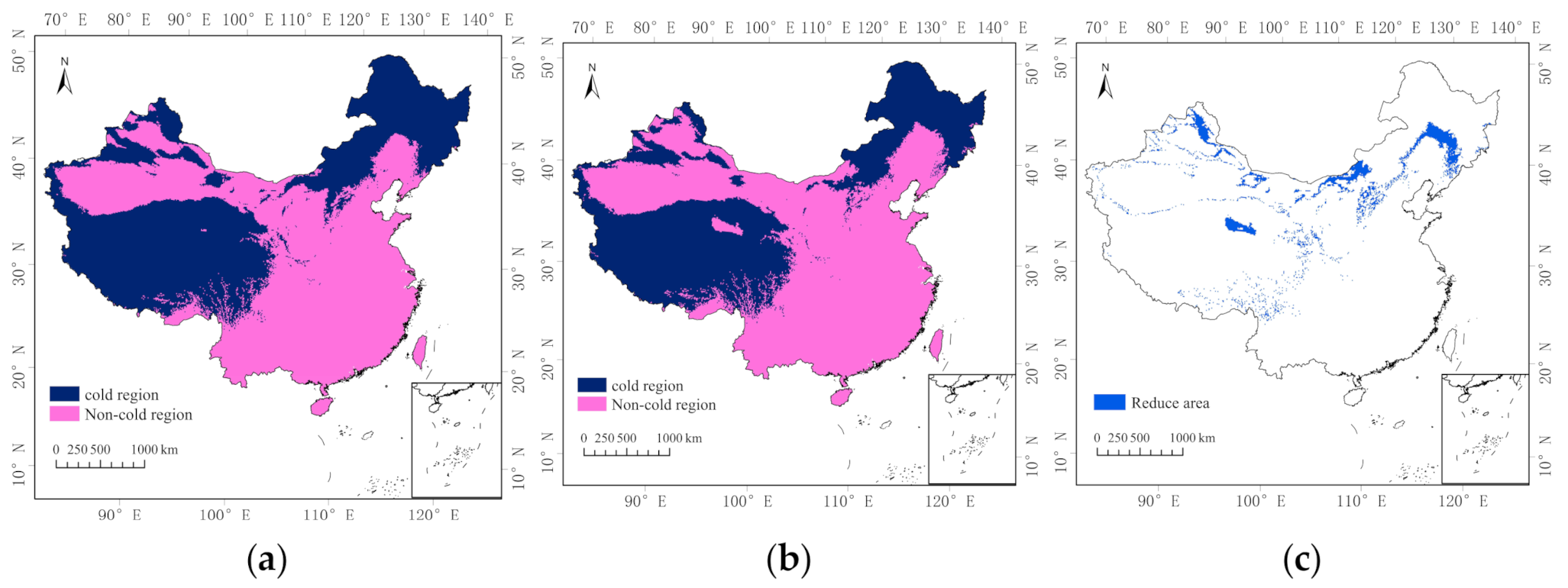
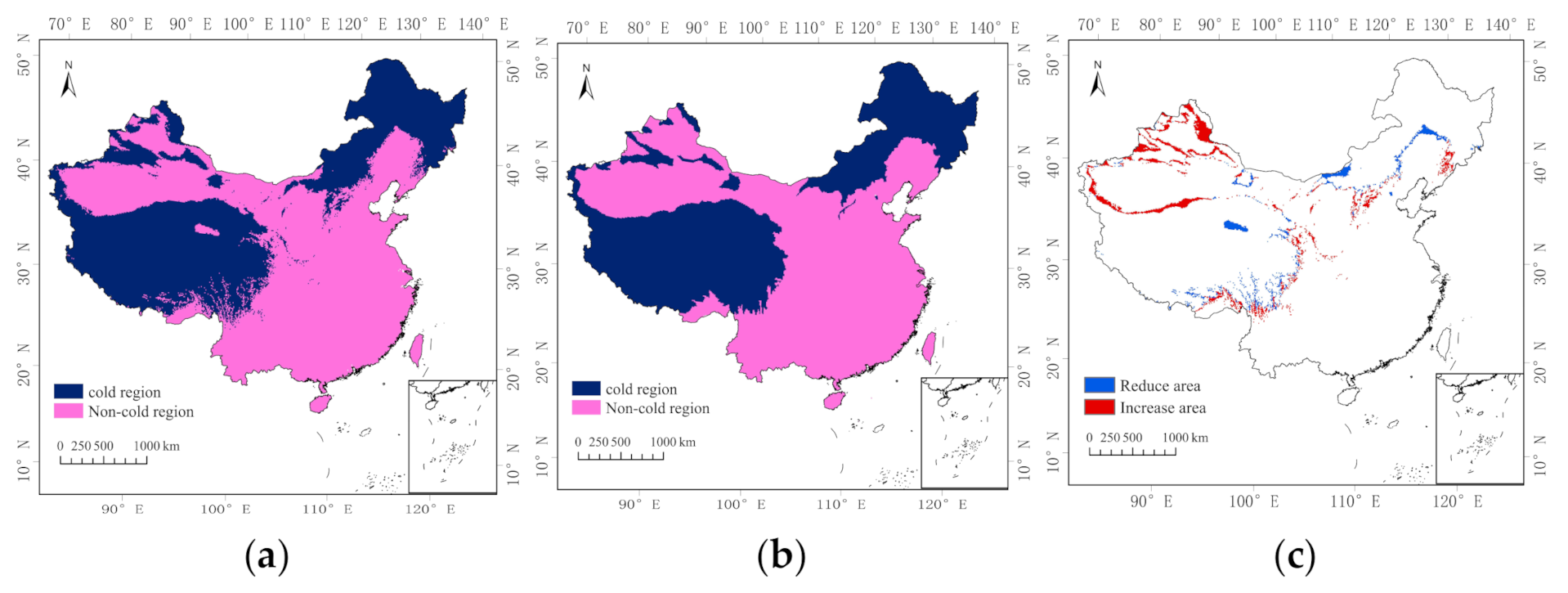
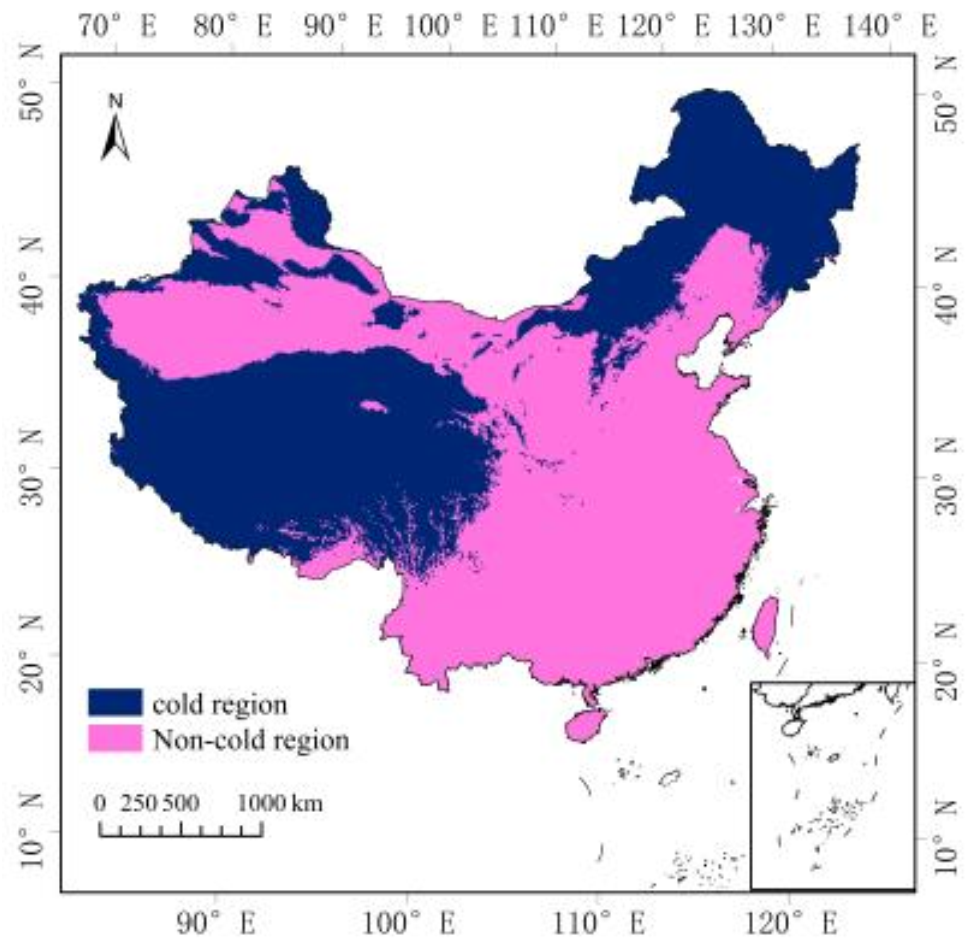
| Administrative District | Area of Cold Region | Administrative District | Area of Cold Region | Administrative District | Area of Cold Region |
|---|---|---|---|---|---|
| Tibet Autonomous Region | 105.06 | Sichuan | 19.85 | Yunnan | 1.10 |
| Inner Mongolia Autonomous Region | 75.04 | Gansu | 16.26 | Liaoning | 0.86 |
| Xinjiang Autonomous Region | 69.00 | Jilin | 11.82 | Ningxia | 0.50 |
| Qinghai | 66.82 | Hebei | 3.95 | Shaanxi | 0.32 |
| Heilongjiang | 54.09 | Shanxi | 3.03 |
| Administrative District | Area of Cold Region | Administrative District | Area of Cold Region |
|---|---|---|---|
| Inner Mongolia Autonomous Region | 12.23 | Sichuan | 1.25 |
| Xinjiang Autonomous Region | 10.62 | Liaoning | 1.21 |
| Jilin | 8.09 | Heilongjiang | 1.17 |
| Qinghai | 4.05 | Hebei | 1.12 |
| Gansu | 3.81 | Yunnan | 0.44 |
| Shanxi | 2.39 | Ningxia | 0.38 |
| Tibet Autonomous Region | 1.46 | Shaanxi | 0.27 |
Publisher’s Note: MDPI stays neutral with regard to jurisdictional claims in published maps and institutional affiliations. |
© 2022 by the authors. Licensee MDPI, Basel, Switzerland. This article is an open access article distributed under the terms and conditions of the Creative Commons Attribution (CC BY) license (https://creativecommons.org/licenses/by/4.0/).
Share and Cite
Wang, Y.; Ma, J.; Zhang, L.; Huang, Y.; Guo, X.; Yang, Y.; Zhao, E.; Zhao, Y.; Chu, Y.; Jiang, M.; et al. Spatial Distribution of, and Variations in, Cold Regions in China from 1961 to 2019. Sustainability 2022, 14, 465. https://doi.org/10.3390/su14010465
Wang Y, Ma J, Zhang L, Huang Y, Guo X, Yang Y, Zhao E, Zhao Y, Chu Y, Jiang M, et al. Spatial Distribution of, and Variations in, Cold Regions in China from 1961 to 2019. Sustainability. 2022; 14(1):465. https://doi.org/10.3390/su14010465
Chicago/Turabian StyleWang, Yumeng, Jingyan Ma, Lijuan Zhang, Yutao Huang, Xihui Guo, Yiping Yang, Enbo Zhao, Yufeng Zhao, Yue Chu, Meiyi Jiang, and et al. 2022. "Spatial Distribution of, and Variations in, Cold Regions in China from 1961 to 2019" Sustainability 14, no. 1: 465. https://doi.org/10.3390/su14010465
APA StyleWang, Y., Ma, J., Zhang, L., Huang, Y., Guo, X., Yang, Y., Zhao, E., Zhao, Y., Chu, Y., Jiang, M., & Wang, N. (2022). Spatial Distribution of, and Variations in, Cold Regions in China from 1961 to 2019. Sustainability, 14(1), 465. https://doi.org/10.3390/su14010465





